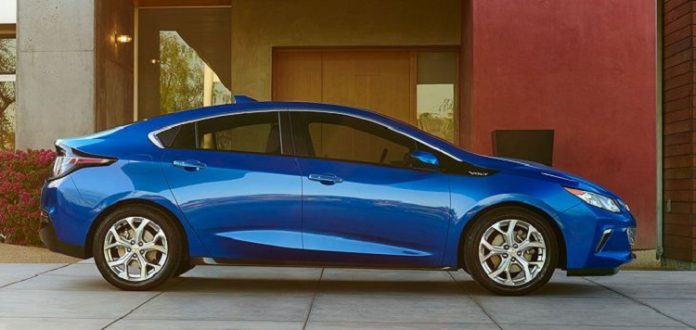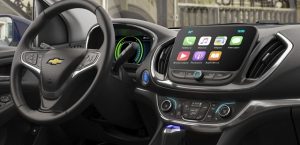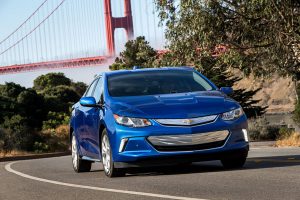Guest Post by Eric Peters

It’s interesting about the Chevy Volt.
Uniquely, it carries around its own recharger – so it’s not tied to a corded umbilical like other electric cars. So it isn’t gimped by a much-abbreviated radius of action, like all other electric cars – the best of which can travel maybe 150 or so miles before their batteries conk out and the car must hook up to an electric IV for an extended recharging session.
When the Volt’s battery pack’s charge runs down, fresh current is fed into it as you drive – without having to stop driving.
It is my sincere desire to provide readers of this site with the best unbiased information available, and a forum where it can be discussed openly, as our Founders intended. But it is not easy nor inexpensive to do so, especially when those who wish to prevent us from making the truth known, attack us without mercy on all fronts on a daily basis. So each time you visit the site, I would ask that you consider the value that you receive and have received from The Burning Platform and the community of which you are a vital part. I can't do it all alone, and I need your help and support to keep it alive. Please consider contributing an amount commensurate to the value that you receive from this site and community, or even by becoming a sustaining supporter through periodic contributions. [Burning Platform LLC - PO Box 1520 Kulpsville, PA 19443] or Paypal
-----------------------------------------------------
To donate via Stripe, click here.
-----------------------------------------------------
Use promo code ILMF2, and save up to 66% on all MyPillow purchases. (The Burning Platform benefits when you use this promo code.)
This is superficially similar to the way a hybrid works but also very different.
Unlike hybrids, the Volt is a true electric car. A motor and batteries provide the primary motive power – what makes it go – as opposed to back-up power. There is a small (1.5 liter) gas engine, but it serves almost exclusively as a generator. It comes on as needed to make electricity for the batteries, not torque and horsepower to turn the wheels. In the Volt, electric motors do that.
All the time.
The Volt’s electric motors always propel the car.
In a hybrid, the electric motor and batteries take over when the vehicle isn’t moving – or moving at low speed. Most can only creep along for a couple of miles – and no faster than about 30 MPH – before the gas engine cuts in and takes over to propel the car, just like any other car.
The main source of movement in a hybrid car is the gas engine.
A few (the plug-ins, which have more powerful battery packs) can travel for about 10-15 miles and at higher road speeds on battery power alone, but revert to internal combustion for propulsion when the charge depletes. Also, anything less than than eggshell-pressure on the throttle causes the hybrid car’s gas engine to kick on – because the battery pack/motors are too weak to provide adequate acceleration by themselves.
Which makes it difficult to avoid regularly using the gas engine, in other words.
As a result, hybrids use a fair amount of gas. The best of them – the plug-in version of the current (2018) Toyota Prius average in the mid-50s. Most of the others are in the low 40s, high 30s. This is good but not nearly as good as the Volt – which uses so little fuel that owners have to worry about the gas in the tank going stale.
The Chevy can travel 50 miles on electricity only – and without driving it like there’s a Faberge egg under the accelerator pedal. The motors/batteries are designed to be powerful enough to accelerate the car adequately without assistance. And if your trip is less than 50 miles, you can plug the thing in when you get there and burn no gas at all on the return trip.
Owners may go a month or more in between fill-ups. Some go months, plural.
No other hybrid can match this fuel sippyness.
And no electric car can match the Volt’s practicality.
Because it doesn’t have to be plugged in to keep on going. If you need to go farther than 50 miles, just keep on going. The onboard generator will generate electricity and keep the electric motors turning the wheels. With its nine gallon tank topped off, the Volt can travel more than 400 miles before it stops for a refill – and that takes less than 5 minutes – as opposed to a 30-45 minute recharge for the conventional electric car, which cannot recharge itself.
No performance anxiety. No range anxiety. The Volt is economical and practical. At least, vs. any electric car you can buy right now.
Which is probably why it isn’t touted as The Future of Transportation while highly impractical, uneconomic electric cars like the Tesla are embarrassingly slobbered over by the largely mechanically and otherwise illiterate car press and force-fed onto the market via “sales” (really, give-them-away) quotas each manufacturer must genuflect before if they wish to sell any cars at all in states like California (a huge market).
It is very odd . . . if the reason for the electric car push is truly green rather than red.
The Volt’s emissions of objectionable combustion byproducts – unburned hydrocarbons, stuff like that – are slim to nil because its combustion engine is both small and very clean-running but also because it doesn’t run most of the time.
If objective threats to planetary or human health are really the criteria, then the Volt passes with the equivalent of a 1600 SAT score – or within the margin of error, at least.
Certainly, its total emissions are very close to the total emissions produced by any electric car, if one factors in the elsewhere emissions that are generated at the utility plants which produce the electricity for them on an industrial scale (as opposed to using a small-scale onboard generator as the Volt does, which is usually not even running – unlike an industrial-scale utility plant).
The Volt does not require billions in new infrastructure “investment” to make it viable as a car for real people who really need to get places without having to stop every 150 miles or so for a 30-45 minute recharge.
It works, it makes sense.
Aye, but there’s the rub.
The Volt has been shunted aside in favor of electric cars that don’t work or make sense; often both things. There is no reason for this . . . if the stated reasons are the real reasons.
But what if the real reason is simply to ban internal combustion, no matter how efficient, practical or clean? To use the pretext of “green” in order to erect a red regime? One in which personal cars are all-electric and very expensive and very impractical and so very few persons can actually afford to own one?
Then it all begins to make sense.
Just a different kind of sense.




Eric…..Thanks for the info.
Only question I have: will this be suitable for pickup trucks?
And there ya go. If it can’t pull a boat, or my travel trailer, it’s just a grocery runner.
” With its nine gallon tank topped off, the Volt can travel more than 400 miles before it stops for a refill …….. ”
That’s only 44 mpg and that, if I read it right and tell me if I don’t, includes the 50 miles provided by the batteries which would presumably be charged by the grid somewhere to start with or would need it after the fill up to keep that average up. If not recharged (assuming it was charged at the start) that would drop range before refill to 350 miles and subsequent gas mileage to less than 40mpg.
My 1500cc diesel rabbit gets that and more and that is on almost 50 year old technology. I would expect more progress over 50 years than that.
In any event, I would like to see a total performance and overall energy efficiency report of the volt on strait gas power vs one of the other hybrids or gas only of similar size for comparison. Batteries and some engineering differences between vehicles aside, that would be (I think) a comparison of drive systems (electric vs hybrid vs normal transmission) with each other. I would expect a straight electric drive to have an advantage in total efficiency over other mechanical drives.
hey guess what. your deisel car burns fuel NONSTOP. the volt only does it occasionally, lets say 50% of the time for a guess… now extrapolate this to millions of cars if they became volt-like. that’s a dramatic reduction in emission over a population.
now they just need to make some real headway into the BrakeDust issue and we might actually be getting somewhere.
It may burn it nonstop but it gets the same mileage.
It takes the same amount of energy to move the same amount of weight over the same distance no matter the source of that energy or whether it uses one fuel source or several different ones to do it.
How much excess energy is wasted in the process, the overall efficiency, is what I’m interested in.
My Saturn, that Obama discontinued, gets over 50 mpg without the electric motor component. Seems like they could get a lot more out of the electric ones than they are. Must be some kind of politics involved as usual that keeps them from that.
Blessings:-}
Somebody tell Al Gore. Don’t hold your breath waiting for his agreement.
Suzuki used to make a car with a one litre engine. It was quick, not fast, and got tremendous mileage. I believe some had a two speed rear end for even greater efficiency.
yep, I had a 1989 Geo Metro made by Suzuki Motors, 993cc triple cylinder engine with 5-speed manual trans and throttle-body fuel injection. Always got 45 mpg combined. Great commuter car. No real service problems for 147k miles. Definitely quick enough and smooth as glass at 65 mph on 12 inch wheels/tires
Those were good little cars, wonder why they died out?
The Suzuki with the one-liter engine, an inline 3 cylinder, was the Chevy Sprint/Geo Metro which got great mileage [50+mpg on the highway] with a zero to sixty time of almost 15 seconds. The Suzuki that had some get up and go had a 1.3 liter inline 4 cylinder that got around the mid/low 40’s on the highway.
I have 2014 Nissan Versa Note. It gets 44 mpg routinely … can get up to 48 in optimum conditions. Even city driving it makes 38.
An electric only makes actual sense if traveling short distances. Any longer range and it doesn’t pencil out. Also, the weight/load you carrying would make a big difference.
IMO, they would make good sense if a fuel cell supplied the electricity as well.
But there is little research into those for small vehicle use since everyone is all hot on batteries for some reason.
And NAPA has every battery packs for each and every hybrid at each and every location, Guaranteed!….see fine print. China has 95%+ of the rare earth minerals required to make those batteries, and if so much as 1% of the vehicles on the road went hybrid, poof – no more batteries are available. Maybe another comes along, maybe not. But if the sun accounts for 99%+ of the weather here on planet earth with the largest percentage of the less than 1% attributed to volcanic heat of ALL types – especially under sea – then you and I are at best, a fucking rounding error. Worry about the India’s and China’s and the rest with no emissions whatsoever. Or go and watch Al Gore and touch yourself.
Volt is not a series hybrid.
http://www.greencarreports.com/news/1096942_2016-chevrolet-volt-powertrain-how-it-works-in-electric-hybrid-modes
“The new 2016 Volt should be viewed as a more conventional plug-in hybrid, with engine torque now being sent to the wheels through a mechanical connection whenever the engine is on.
The 2011-2015 Volt has one motor that powers the wheels, and a second that acts as an engine-driven generator to produce electricity when battery capacity is depleted.
The 2016 Volt, on the other hand, has a pair of motors that are roughly the same size, one or both of which can power the car.”
It is unfortunate because I believe series hybrids are the most rational choice. But sadly no one builds them.
Sounds like more stuff to break and get you in the shop sooner. Like on my 06′ Escape Hybrid. You got an engine and a battery unit, both of which can fail in a variety of ways. I had a tiny cooling fan die, no light came on, and that let the wiring overheat and die, which let another component die, which led to overheating issues causing us to limp 40 miles home stopping every mile, or so, to let the car cool down enough to go on. Even if the car was running only on the engine, the broken battery side still causes it to stop. It was an expensive fix thanks to that cascade of failures. Now that the state exemption for hybrids in HOV lanes is going away, we’ll be switching over to an evil gas guzzler.
I have to say, I did enjoy driving it. It was sort of a game to see if you could accelerate at just the right amount to move, but not trip the engine on. Once you got to 30-ish, it was going to trip anyway, but it was fun to watch the efficiency gauge and try to push it.
……but, but……I bought carbon credit off-sets with my college money……oh no…….
Interesting. I didn’t know the Volt functioned in this way. It is very similar to the way diesel locomotives work–a large diesel generator that powers electric motors at the wheel sets.
It does not change the baseline energy efficiency as Anon pointed out, but it does make for a very versatile commuter vehicle.
Imagine for a minute if they did this with the VW 01-05 TDI type engine, except scaled down to a 2 or 3 cylinder…1’ish liter. Calibrated to run at max efficiency turning a generator.
I already get between 40-50 mpg with the 1.9L TDI depending on terrain. A pure speculative guess at a diesel electric version would probably up that mpg by 25%.
Don’t make sense at the expense of Musk making dollars. Yea, pun intended.
Man I wish you guys/gals, who post under the insipid Anonymous name, would have the stones to stand up, exercise a nanogram of gray matter, pick a handle & stick with it, at least mostly; doing so would give your comments context & more credibility because others can compare current ones with those made in the past.
It’s not like the Admin requires signing in 1st with F-Book, GagMail, etc. before allowing one to speak up.
Electrocars, regardless of the engineering design, reduce the amount of total emissions from IC engines, and reduce the total amount needed of liquid transportation fuels.
The Volt, if used only in around-town commuting and shopping, need not use gasoline at all. You get home, plug in the charger–from your house or via solar.
Still need to drill for oil and natural gas. Gotta have paved roads, tires, pvc pipe and nylon undies.
Great article. Already own a Chevy Cruse diesel that averages about 53 miles per gallon, 63 on the highway…
Forget about the pros and cons of electric vs IC vs hybrid. The push for electric is to restrict travel and push/force everyone into stack and pack cities. This is the Agenda 21 globalist goal. This is one of many ploys of control. Think global warming, carbon tax, cashless society, negative interest, ACA, forced vaccines, DOE, wilding project, militarization of police, etc…
Yeah, but if you wanted people living in cities like anthill, you don’t need to force them. All you need to do is keep all the jobs there and make them cool. Just like now. You don’t need to force people to drive electric cars, either, just make them cool and add ridiculous subsidies to them. Just like now!
Like I said, it is one of many ploys.
Eric should stick to what he knows and that’s not any EV or hybrid car. He obviously hasnt driven any of the systems.
The usual hybrids are powerful not slow because the gas engine powers it alone when just cruising but under acceleration the electric motor gives a big boost of torque,eg the honda.
Yes some
like old toyota prius have the gas engine cut in for more power when needed but if u want to drive for economy without using gas you can. You can do both.
The new Volt when under electric only power has to carry the weight of the gas motor, a 1.5 litre and the gas. Its then not bettter performance than a full electric that does not have that extra weight or as efficient such as Mitsubishi iMiev. Hence only 50 miles electric range for the Volt If 50 miles range is enough and owners need to worry about the gas going stale, then he has no business criticizing the full electrics that do triple that range. Also you dont get to criticise the performance of other systems and then praise using a 1.5 litre with 25% power loss in conversion to electric power. Lets say this 1.5 has 75hp. With a conversion loss to the electric motor that’s now 50hp. Thats gutless in a gas only car, but this thing has the weight of not only gas engine and tank, but also electric engine and battery. Fair to say it would be very slow. So ‘just keep driving’ and with good power is crapola. This needs to not just cruise under this high weight and low power as other hybrids do, but also accelerate from that power to weight, which would be a struggle. It has a particular advantage which is only unlimited range on gas. Performance is NOT another advantage.
So many opinions, so little care for others,
no wonder we are fucked as a species.
does it do this? does it do that? mine is much bigger and faster,
who fucking cares.
The post is informative, it brings up ideas you will never hear from the fan boys of tesla or toyota-prius drivers.
personally I think prius drivers are pussies.
Anyone alive for the next 30-40 years will still be driving gasoline cars,
because it is a profitable business, all EV and Hypbrids are just a different form of profit, that has nothing to do with saving the planet.
in the future (+40 yr), there will be so many laws and rules that will make driving in general, only affordable to the 1%.
everyone else will be getting their solyent green delivered by amazon drones.
So the Volt is an Electric Drive (transmission) that has 2 sources of energy, a battery pack and a gasoline Gen-Set. We’re getting to the goal (to the point of having a reliable electric drive vehicle, that can be easily refueled: The Fuel Cell Vehicle is the destination, as you pull in to a fueling station and fill the car as you would with a Compressed Natural Gas fueled vehicle, and leave on your way.). Finally GM does something that is logical, forward thinking and in line with technology they purchased in the 1930s, when they bought the Electro-Motive Corporation (that made Diesel Generated-Electric Drive Locomotives).
Electric drive has been around since the Germans built the U-Boats of World War 1. It’s safe, reliable and proven. GM took this technology and use it in its RTS line of Buses seen in most US cities. So we’re heading in the correct direction. Now, if GM will fix the HCCI engine where it could actually generate electricity in “diesel (compression ignition) mode” (or figure out how Mazda is doing this with their SPCCI engine that will debut in the 2019 model year), vehicle range would be outstanding (getting around 520 miles per 9 gallon tank full ~ about a 30% increase per Mazda’s initial tests).
Finally, if the generator engine is run at a constant speed, vehicle emissions will be MUCH LOWER, as the mixture is not enriched to increase torque and accelerate the vehicle. But if the older EMD Locomotives or the GM RTS buses were the example, this won’t be the case.